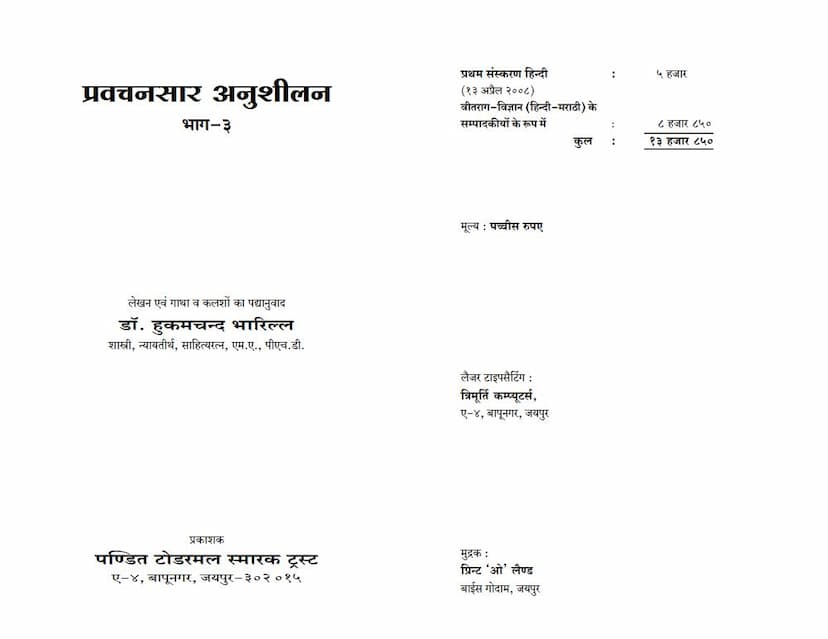Pravachansara Anushilan Part 03
Added to library: September 2, 2025

Summary
The provided text is the third part of "Pravachansara Anushilan" by Hukamchand Bharilla, published by Todarmal Granthamala, Jaipur. This volume focuses on the "Charananuyog Suchak Chulika" (Conclusion indicating Conduct-based scriptures) of Acharya Kundakunda's "Pravachanasara," covering verses 201 to 275.
The book begins with a prologue (Prakirakiya) praising the author, Dr. Hukamchand Bharilla, as a prominent scholar in the Jain community in the 21st century. It highlights his prolific writing, with over 70 published works translated into various languages and reaching a global audience through the internet. Dr. Bharilla's extensive literary contributions, exceeding 8,000 pages and published in over 4.2 million copies, have been recognized by academic institutions, with research papers dedicated to his work and scholarships provided to researchers.
The text then delves into the commentary on Kundakunda's "Pravachanasara," a profound and subtle philosophical work. Dr. Bharilla aims to make its complex concepts accessible to the common reader through this "Anushilan" (study and commentary). The importance of patience and dedication is emphasized for understanding "Pravachanasara." The book acknowledges the foundational work of spiritual figures like Pujya Shri Kanji Swami in popularizing Kundakunda's teachings and Dr. Bharilla's role in making this spiritual literature accessible through his "Anushilan" series.
The core content of this volume, as outlined in the index, covers verses 201 to 275 of "Pravachanasara." The commentary, drawing from the "Tattvapradeepika" commentary by Acharya Amritachandra and "Tattvavrutti" by Acharya Jayasena, along with poetic translations and interpretations by Vrindavandasji and Pandit Devidasji, and insights from spiritual masters like Shri Kanji Swami, expounds on various aspects of the Jain path to liberation.
Key themes explored include:
- The Nature of Character (Charitra): The text emphasizes that true character is rooted in understanding the nature of the self (Dravya) and its actions, leading to a virtuous path.
- The Path to Liberation: The commentary stresses the importance of adhering to the teachings of the Jinas (Jain Tirthankaras) and the principles of right faith, knowledge, and conduct (Samyakdarshan, Samyakgyan, Samyakcharitra) as the sole means to overcome suffering and achieve liberation.
- The Practice of Asceticism (Shramanya): The verses detail the rigorous practices of monks, including detachment from worldly possessions and relationships, adherence to the five great vows (Panchamahavratas), discipline in conduct (acharas), and the meticulous observance of the 28 fundamental vows (Mulas)—a path essential for spiritual progress.
- The Significance of External and Internal Conduct (Dravya and Bhava Lings): The text elaborates on the necessity of both outward austerity (like nudity) and inward spiritual purity for spiritual attainment. It clarifies that external practices without inner realization are insufficient.
- The Role of the Guru: The importance of guidance from a qualified guru is highlighted for navigating the spiritual path and understanding the scriptures.
- The Nuances of Ascetic Practices: The commentary details the 28 essential vows for monks, explaining their significance and the proper way to observe them. It also touches upon the concept of "chedo-upasthapana" charitra, a process of correction and re-establishment in spiritual practice.
- Distinguishing True Monks from Imposters (Shramanabhasa): The text distinguishes between genuine ascetics and those who merely wear the outward appearance of monks without inner realization, emphasizing the futility of mere external practices without the core principles of right faith and knowledge.
- The Importance of Right Association (Sat-sang): The text stresses the need to associate with virtuous individuals and avoid the company of those who are spiritually negligent or have worldly attachments, as association greatly influences one's spiritual path.
- The Imperative of Self-Realization: Ultimately, the commentary guides the reader towards the realization of the true self, emphasizing that mere adherence to rituals or scriptures without this core understanding is insufficient for liberation.
The book concludes by reiterating the ultimate goal of spiritual practice: the attainment of the true self, the soul, which is the source of eternal bliss. The essence of the teachings is to shed all external and internal attachments and find refuge solely in the pure, blissful soul.